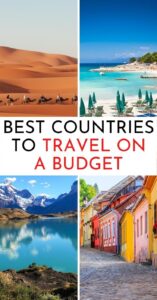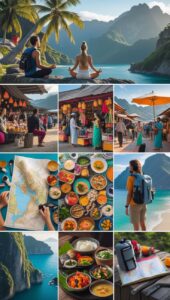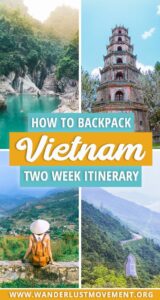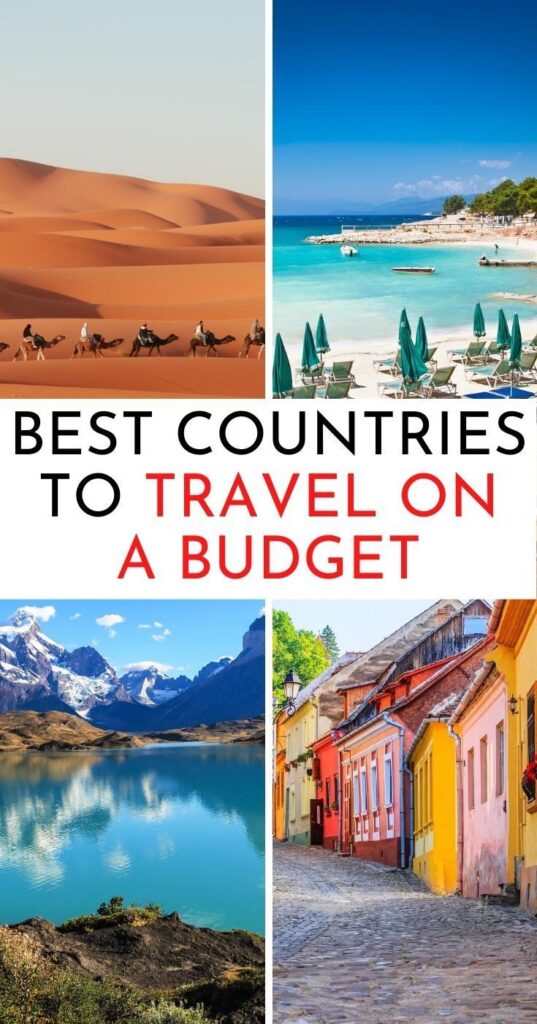Hello! Are you ready for the ultimate Vietnam backpacker itinerary for 2025? Vietnam is more than just another destination; it’s an experience. Its misty mountains, vibrant cities, and stunning coastlines make it the perfect playground for solo backpackers looking for a social experience. This Vietnam backpacker guide will take you to the country’s most iconic spots and hidden gems, where you can easily and unforgettably meet other travelers and connect with the local culture.
One of the best things about Vietnam is the convenience and affordability of hostels and homestays. Affordable dorms and private rooms are available for just a few dollars a night, and many hostels offer group tours, shared dinners, and fun activities that will help you make new connections.
In this Vietnam travel blog, we will introduce the best social hostels to stay from North to South Vietnam, so you can explore great places, build relationships and create unforgettable memories throughout your trip.
The best backpacking trips in Vietnam
To make the most of this journey, we have arranged the itinerary from North to South, allowing you to experience the diversity of Vietnam’s landscapes and culture.
Here’s a guide on how to prioritize based on your travel time:

2 weeks in Vietnam
When planning a 2-week backpacking trip in Vietnam, focus on either the North or South of Vietnam to get the most out of each destination.
Northern Vietnam has many beautiful landscapes such as Sapa and Ha Giang, while Southern Vietnam has many beautiful beaches and the attractive Mekong Delta.
The perfect place to end your trip in either case is Hoi An, famous for its charming lanterns and tailor-made clothes. It is centrally located with easy airport access.
3 Week Backpacking Itinerary in Vietnam
This 3-week Vietnam itinerary allows you to explore the highlights of Vietnam at a more leisurely pace. In the north, choose between the Sapa/Ha Giang Loop, depending on the experience you want.
If this is the ideal season for Northern Vietnam, here are some itinerary suggestions to help you make the most of your trip:
- Hanoi : 2 full days
- Cat Ba (Ha Long Bay) : 2-3 days
- Ha Giang/Sapa route : 3-4 days
- Ninh Binh : 2 days
- Phong Nha : 2 days
- Hue : 2 days
- Hoi An : 2 days
- Nha Trang/ Mui Ne : 2 days
- Ho Chi Minh: 2 days
- Da Lat/Phu Quoc: 2 days.
4 Week Backpacking Itinerary in Vietnam
This 1 month Vietnam itinerary allows you to explore all the must-see destinations in the country. A month in Vietnam gives you time to explore each region in more depth and at your own pace.
- Hanoi : 2 full days
- Cat Ba (Ha Long Bay) : 2-3 days
- Ha Giang: 3 days
- Sapa : 3 days
- Ninh Binh : 2 days
- Phong Nha : 2 days
- Hue : 2 days
- Hoi An : 3 days
- Nha Trang: 2 days
- Mui Ne : 2 days
- Ho Chi Minh: 2 days.
- Da Lat/Phu Quoc: 2 days.
When to visit Vietnam?
Vietnam’s climate varies greatly from north to south, so the best time to visit depends on which area you plan to explore. The country has distinct dry and wet seasons, but they don’t occur at the same time across the country, allowing you to plan based on the best weather in each area.
Northern Vietnam (Hanoi, Sapa, Ha Giang, Ha Long Bay)
The ideal time to visit the North is from December to May, when the weather is cooler and drier. December to February can be quite cold in the mountains, especially in places like Sapa, so make sure to bring plenty of warm layers. If your dream is to see the rice fields, come from March to May. The temperatures start to warm up and the skies are clear, making it perfect for hiking and outdoor activities in Sapa and the Ha Giang Loop.
Central Vietnam (Hoi An, Hue, Phong Nha)
Central Vietnam has a temperate climate most of the year, but the best time to visit is from January to June. During this time, you can expect sunny days and warm temperatures, ideal for beach time or visiting Hue, where you can admire the French colonial architecture.
Southern Vietnam (Ho Chi Minh City, Phu Quoc, Mekong Delta)
The South has a tropical climate with warm temperatures all year round, but it is best to visit from November to April during the dry season. This is the perfect time to explore the Mekong Delta and the famous floating markets in Can Tho.
Vietnam backpacking route
In this guide, we’ll take you city by city through the best Vietnam has to offer, from bustling metropolises to tranquil mountain villages and tropical islands. For each destination, we’ve put together our top recommendations for must-see attractions, unique activities and the best backpacker hostels in Vietnam where you can meet other travellers.
Get ready to explore every corner of Vietnam, from the stunning rice terraces of Sa Pa to the bustling streets of Hanoi, as we share top tips and budget options to make your backpacking trip memorable.
Let’s explore the highlights of Vietnam, city by city!
Hanoi: The heartbeat of Vietnam
Hanoi will likely be the starting point for your journey through Vietnam (though Ho Chi Minh City could also be an option—you can easily adjust this itinerary later). Hanoi offers a mix of history, culture, and unique local experiences.
First on the list is the iconic Chinatown—a narrow alleyway where trains pass just inches from local homes. It’s an unforgettable sight, especially with a cup of coffee from one of the railway-side cafes.
To delve deeper into Vietnam’s history, head to Hoa Lo Prison – a museum that provides insight into the city’s past, known as the “Hanoi Hilton” during the Vietnam War.
And of course, an evening at Beer Hoi Street is a must for backpackers. Famous for its cheap draft beer and lively atmosphere, it is the perfect place to mingle with locals and tourists.
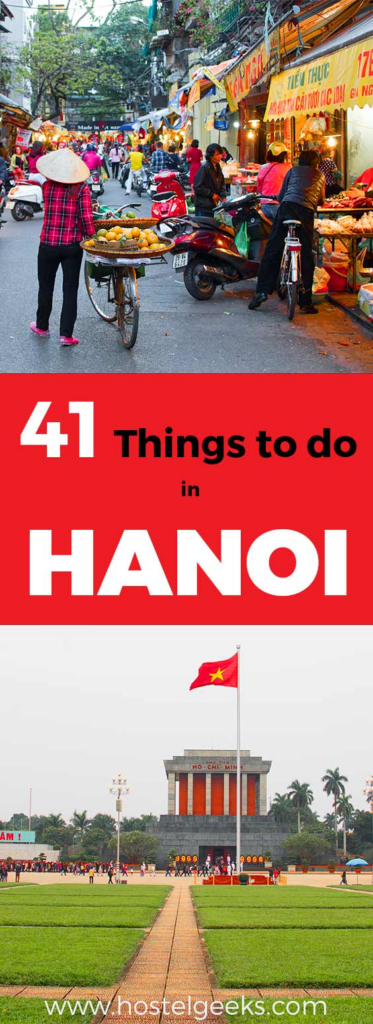
Tips for backpacking in Hanoi
Hanoi has plenty of local eateries serving up delicious and affordable Vietnamese food. Look for places like Bun Cha Hang Manh for a bowl of authentic bun cha, or street vendors selling Banh Mi for a cheap and delicious sandwich. (Yes, there are banh mi in Vietnam!)
To explore the many markets in the Old Quarter, be prepared with cash and practice bargaining. Remember, a polite smile and a little haggling can make a big difference.
Social housing in Hanoi
Nexy Hostel is a great choice for a great social atmosphere in Hanoi’s Old Quarter. The hostel is well-equipped to make friends, with cozy dormitories, a rooftop terrace with city views and a lively common area where guests gather to play games and take part in activities. The friendly staff organise group trips and can help advise on must-see spots, making it easy to connect with others and immerse yourself in Hanoi’s culture.
This hostel fills up very quickly so I recommend booking as soon as you have a date. In case it is full, here are the best hostels in Hanoi.

How to get around in Hanoi
Walking is the easiest way to get around Hanoi in the Old Quarter. Motorbike taxis are widely available for those who want to get around faster. Local buses also operate in the city and are a cheap way to get a more local experience if you’re feeling a little adventurous! However, be aware that drivers may not speak English so it can be a little trickier than taking a Grab (Vietnamese taxi/motorbike taxi).
For further destinations, like the stunning limestone karsts of Ha Long Bay, there are plenty of bus services or guided tours available. We often use the website 12GoAsia, which is a reliable platform for booking buses around Vietnam (and Southeast Asia).
Ha Giang: Gateway to Vietnam’s Most Epic Road Trip
Ha Giang is home to a winding, winding, mountainous route that has become one of the most exciting backpacking experiences in Vietnam. This 2-3 day motorbike trip will take you through spectacular landscapes of limestone cliffs, terraced rice fields and misty valleys, offering endless photo opportunities and unforgettable scenery.
Along the way, you will pass through remote villages where you can witness the traditional lifestyle of Vietnam’s ethnic minorities, adding a new cultural layer to the adventure.

Tips for backpacking Ha Giang
Ha Giang can be reached by bus from Hanoi and you should plan to stay one night in Ha Giang before starting your journey to ensure you are well rested.
Bring a good camera or GoPro to capture the beautiful scenery and pack light to make it easier to travel. If you have a large backpack, ask your accommodation to keep it for you (most guesthouses in Ha Giang and Hanoi will do this for free).
Getting around Ha Giang can be a challenge, so if you’re new to motorbikes, consider joining a guided tour rather than going it alone. Not sure how to ride a motorbike or don’t feel comfortable enough? You can hire an easy rider. If you choose an easy rider, you’ll have a driver, so you can sit on the back and enjoy the views and the feeling.
Social accommodation in Ha Giang
For a relaxed and social stay in Ha Giang, NoMadders Hostel is a top choice. Set in a picturesque area, this hostel offers a welcoming atmosphere and is the perfect place to meet other travellers eager to explore the Ha Giang Loop.

Sapa: Vietnam’s Mountain Paradise
Sapa is a dream destination for those drawn to its majestic mountain landscapes and lush rice terraces. A must-do is the Sapa Rice Terraces trek, where you will walk among stunning green fields cascading down the mountainside, often guided by local Hmong villagers who share their insights into their culture and way of life.
For those looking to reach new heights, Mount Fansipan, known as the “Roof of Indochina,” is an exhilarating climb. Today, you can also take a cable car to the top. Don’t miss Mount Fansipan, as it offers panoramic views of the Hoang Lien Son mountain range.

Backpacking tips in Sapa
The best time to visit the famous rice terraces is between May and September, when they are lush and green, although the golden harvest season in September is also beautiful. Remember that Sapa’s cool climate means you should bring a light jacket and rain gear, as the weather can change quickly in the mountains.
Sapa can be reached from Hanoi by overnight bus or train, with bus services connecting Lao Cai to Sapa town. Once there, motorbikes are available for rent to explore the surrounding areas, although many visitors prefer to hike.
Social hostel in Sapa
For a comfortable and sociable stay, Lustig Hostel in Sapa is a top choice. Known for its cozy atmosphere and mountain views, Lustig Hostel is a great place to meet other travelers and organize group hikes. The staff can connect you with local guides for hiking through the rice terraces, and the common areas provide a welcoming space to share stories and plan your next adventure. The dorms are comfortable and affordable, and the hostel’s central location makes it easy to reach Sapa’s main attractions.

Cat Ba Island: Gateway to the beauty of Ha Long Bay
Cat Ba Island is the perfect base for exploring the world-famous Ha Long Bay. Famous for its emerald waters and thousands of limestone islands, a boat tour through Ha Long Bay is a must for any backpacker. Many tours even include stops for kayaking and swimming, perfect for taking in the breathtaking views of the bay from up close.
Back on the island, don’t miss Hospital Cave, a unique wartime structure hidden in the cliffs. The cave served as a hospital and safe house during the Vietnam War and offers a fascinating insight into Vietnamese history.

Cat Ba backpacking tips
Cat Ba Island has some great seafood options—be sure to try local dishes like grilled squid and seafood hotpot at the small eateries near the river. For budget-friendly meals, head to Cat Ba Market for street food and local favorites at great prices. Bring cash, too, as many places on the island still don’t accept cards.
Social hostel in Cat Ba island
For a social atmosphere and convenient location, Republic Hostel is a top choice in Cat Ba. The hostel’s welcoming atmosphere, rooftop terrace and nightly group dinners make it easy to meet other travellers. Republic Hostel also organises group tours of Ha Long Bay, which is a great way to experience the bay while making new friends. The staff can help you arrange everything from boat tours to motorbike rentals, ensuring you get the best of what Cat Ba has to offer.

How to get around Cat Ba Island
Getting to Cat Ba from Hanoi is simple. You can take a combination bus and ferry ticket from Hanoi straight to Cat Ba Island, this is the least complicated option.
Once on the island, renting a motorbike is the best way to explore independently. The roads are picturesque and relatively quiet, making it easy to get around and visit famous places like Military Hospital Cave or the scenic spots around Cat Ba National Park.
Ninh Binh: Vietnam’s Inland Ha Long Bay
Ninh Binh is often referred to as “Halong Bay on land” because of its stunning limestone karsts and tranquil rivers. Begin your exploration with a boat trip through Tam Coc, where you’ll float past rice paddies and towering cliffs—an experience that’s both peaceful and awe-inspiring. For stunning views of Tam Coc, hike up to Hang Mua, where stairs lead to a mountaintop pagoda and panoramic views of the surrounding river valleys and limestone mountains.
Just outside Ninh Binh, the majestic Bai Dinh Pagoda, the largest temple complex in Vietnam, is worth a visit to admire its vast pagodas, serene courtyards and towering Buddha statues.
Ninh Binh backpacking tips
Visiting Tam Coc on a boat tour early in the morning can help you avoid the crowds and enjoy the quiet surroundings. For cheap meals, look for local eateries serving com chao (crispy rice) and bun rieu cua (crab noodle soup).
If you are planning to visit Bai Dinh Pagoda, remember that this is a large complex, so set aside at least half a day to explore.
Social accommodation in Ninh Binh
Tam Coc Bungalows are a favorite choice of backpackers in Ninh Binh, offering a relaxing atmosphere right along the river. The bungalows are surrounded by lush gardens and have great views of the river.

How to get around in Ninh Binh
Ninh Binh is easily accessible from Hanoi by bus or train, the journey takes about two hours.
When in Ninh Binh, cycling is a great way to explore the area’s attractions, as the roads are relatively flat. Motorbike rentals are also popular if you want more flexibility when visiting places like Mua Cave and Bai Dinh Pagoda.
Phong Nha: The Caving Capital of Vietnam
Phong Nha is a paradise for adventurers and nature lovers, with some of the most spectacular caves in Vietnam. Start with a visit to Phong Nha Cave, where you’ll see impressive stalactites and unique rock formations. Next, head to Paradise Cave, often considered one of the most beautiful caves in the world, with towering stalactites and vast chambers.
For a more active adventure, Dark Cave is a must-see—after ziplining to the entrance, you’ll wade through mud baths, swim in an underground river, and explore the cave with a headlamp, making for an unforgettable hands-on experience.
For the truly adventurous, hiking in the area is also available, offering a way to explore the area’s natural beauty.
Phong Nha backpacking tips
The area is quite rural, so bring cash, as many places still prefer cash. For those who want to explore further, Phong Nha has multi-day caving and jungle trekking tours that allow you to explore more remote, lesser-known caves. It’s not cheap, but it’s a great experience.
The best way to get to Phong Nha from Hanoi or Hue is by sleeper bus or train. Once in town, renting a motorbike is an ideal way to explore independently, especially to reach caves such as Thien Duong Cave, about a 20-minute drive from Phong Nha town.
Social Hostel in Phong Nha
Phong Nha Tuan Garden House offers a cozy, intimate atmosphere with stunning views of the surrounding mountains and countryside. With its spacious garden, swimming pool and friendly communal atmosphere, it is the perfect place to relax after a day of caving.

Hue: The historic heart of Vietnam
Hue, the ancient capital of Vietnam, is steeped in history and charm. Start with a tour of the Imperial City, a vast complex of temples, palaces and ancient gates set within impressive walls and moats. A walk through its ruins and preserved grounds will give you a glimpse into the royal lifestyle of the Nguyen Dynasty.
For a more offbeat adventure, head to the Abandoned Water Park, an unusual, slightly creepy spot with decaying slides, a dragon-shaped aquarium and overgrown attractions. It’s a unique, little-known destination that’s popular with backpackers looking for unique photo opportunities.
Backpacking tips in Hue
Hue is famous for its unique regional cuisine, including bun bo hue (spicy beef noodle soup) and banh khoai (crispy stuffed pancakes). For an authentic experience, try eating at local markets like Dong Ba Market, where you can sample a variety of traditional foods at affordable prices.
Social hostel in Hue
For a cozy, social stay, Amy 2 Hostel Hue offers a warm, local experience. The hostel’s welcoming family atmosphere and home-cooked meals make you feel like you’re staying with friends, not just renting a bed. Guests often gather in common areas to eat and share travel stories, making it an ideal place for solo backpackers to meet others.

How to get around in Hue
Hue is compact enough to explore on foot or by bike, and most major attractions, including the Imperial Citadel, are just a short drive from Chi Homestay. For the Abandoned Water Park and further afield, renting a motorbike is a convenient option.
Hue is also well connected to other destinations, with trains, buses and flights to cities such as Da Nang and Hanoi.
Hoi An: The most charming ancient town in Vietnam
Hoi An is famous for its picturesque streets, colorful lanterns and riverside views.
Start your tour with a drive along the breathtaking Hai Van Pass, a stunning coastal road with panoramic views of mountains and sea—perfect for a day trip or as a scenic route en route to Hoi An.
Back in town, sign up for a Vietnamese cooking class, where you’ll learn how to make local dishes like cao lau and banh xeo from scratch. Another must-do is the Coconut Boat Tour, where you’ll float along the water in traditional round bamboo boats through coconut-lined canals—a unique way to see the Hoi An countryside.
And of course, Hoi An is the place to go for custom tailoring. Local tailors can create high-quality, affordable garments in just a day or two, so you can take home a uniquely Vietnamese piece of yourself.

Backpacking tips in Hoi An
Hoi An Ancient Town is best explored early in the morning or late at night, when the streets are quieter and the light is perfect for photography. For cheap eats, try the street food stalls near the Japanese Bridge or the riverside cafes serving local specialties such as white rose dumplings.
While tailored clothing is the highlight here, remember to negotiate the price and allow extra time for adjustments to ensure a perfect fit.
Social hostel in Hoi An
If you’re looking for a relaxed and social atmosphere, Under the Coconut Tree is a great choice. Just a short walk from An Bang Beach, this hostel’s bamboo huts, hammocks and relaxed atmosphere provide the perfect backdrop for connecting with other travellers.
How to get around Hoi An
Hoi An is very walkable, especially in the Old Town, but cycling is a popular way to get around, and many hostels and guesthouses offer free bike rentals.
If you are planning to explore the Hai Van Pass, renting a motorbike is ideal, or you can join a guided motorbike tour. Note that the Hai Van Pass lies between Hue and Hoi An, so you can join an easy motorbike/bicycle tour as a way to travel between the two cities.

Nha Trang: Vietnam’s Beachside Playground
Although we don’t like the city itself, Nha Trang is famous for its beach scene, water sports and natural beauty. A short trip from the city takes you to Van Phong Bay, a beautiful spot with crystal clear waters and pristine beaches that are ideal for snorkeling, diving or just relaxing.
Closer to town, visit the historic Po Nagar Cham Towers—ancient temples dating back to the 8th century. These impressive towers are still used by the Cham people for worship and offer panoramic views of the Cai River, making them a fascinating cultural and scenic attraction.
Nha Trang backpacking tips
Nha Trang offers a wide range of dining options, from beachside eateries to local seafood spots. For a unique meal, try the seafood restaurants near Bai Dai, where you can pick your fish straight from the tank.
If you want to explore more secluded areas of Van Phong Bay, consider hiring a local boat tour—just make sure to book through a reputable source to avoid overcrowded or commercialized areas.
Social accommodation in Nha Trang
For backpackers, The Alley is a top choice in Nha Trang. It has a cozy, communal atmosphere with plenty of opportunities to meet other travellers, thanks to its lively communal areas and organised outings. Located close to the beach and Nha Trang’s central attractions, The Alley is perfectly located for exploring both the town and the beach.

How to get around Nha Trang
Getting around Nha Trang is easy, with taxis and Grab readily available. To get to Van Phong Bay, renting a motorbike is ideal for flexible exploration or you can join a day tour that includes transportation.
For local attractions, such as Po Nagar Cham Towers, renting a motorbike or bicycle will allow you to experience the area more freely.
Dalat: Vietnam’s “City of Eternal Spring”
Located in the Central Highlands, Dalat is a refreshing retreat known for its cool climate, picturesque landscapes, and quirky attractions. Start with a tour of the fascinating Crazy House—an architectural wonder that feels both magical and dreamlike, with its winding staircases and surreal design.
Just outside of Da Lat, Pongour Falls is a must-see; this multi-tiered waterfall makes for a spectacular backdrop, perfect for photography or a relaxing afternoon picnic.
For coffee lovers, coffee plantations around Da Lat offer tours where you can learn about Vietnam’s coffee production process and sample some of the world’s best coffee right at the place of production.

Tips for backpacking in Dalat
Da Lat Market is a great place to sample local flavors—try banh trang nuong (Vietnamese pizza) at Da Lat Night Market for delicious street food. With the cool climate, pack an extra layer for the evenings, as it can get surprisingly chilly.
If you visit Crazy House, consider arriving early in the morning to admire the surreal architecture without the crowds.
Da Lat can be reached by sleeper bus from Ho Chi Minh City, or you can fly into Da Lat’s Lien Khuong Airport for a quicker option. Once in town, motorbikes are a popular option for getting to places like Pongour Falls, while taxis or Grab can be used for shorter distances.
Social hostel in Dalat
There are plenty of hostels and homestays in Da Lat, but not many of them are social. Tigon Da Lat is a backpacker favourite, known for its friendly atmosphere and community feel.

Mui Ne: A Combination of Adventure and Relaxation
Mui Ne is famous for its unique White Sand Dunes, a surreal landscape that feels more like a desert than a tropical destination. Sunrise over the dunes is a magical experience, with undulating sands and spectacular light perfect for photography. You can also rent ATVs or join a jeep tour to explore the dunes in style.
Back in town, Mui Ne beach is ideal for water sports like kitesurfing, thanks to the steady sea breeze. For a quieter experience, just relax on the beach and enjoy the laid-back atmosphere of this coastal town.
Tips for backpacking Mui Ne
The white sand dunes are best visited early in the morning to avoid the heat and crowds at noon.
For budget meals, Mui Ne has plenty of seafood restaurants and local eateries along the beach where you can enjoy fresh fish and traditional dishes at affordable prices.
If you’re interested in kitesurfing, Mui Ne is one of the best places in Vietnam to learn and rent kites, so ask around the beach for deals and beginner packages.
Social hostel in Mui Ne
For a lively, social atmosphere, iHome Backpacker Resort is a popular spot in Mui Ne. This hostel combines the fun of a beach resort with the community spirit of a backpacker hub, offering activities like unlimited beer hours and beach games. With its own private beach, pool, and lively common areas, iHome Backpacker Resort makes it easy to meet other travelers and enjoy Mui Ne’s coastal beauty.

How to get around in Mui Ne
The easiest way to get to the White Sand Dunes is by jeep tour. Alternatively, you can rent a motorbike for more flexibility, although the sandy roads can be difficult for inexperienced drivers.
You can easily get to Mui Ne by foot, bicycle or motorbike, and can also take taxis for short trips around town.
Ho Chi Minh City (Saigon): Vietnam’s bustling capital
Ho Chi Minh City, or Saigon, is a vibrant hub filled with history, culture and relentless energy. Start your exploration with the War Remnants Museum, which offers a sobering look at the Vietnam War through powerful exhibits and photographs. For a deeper dive into the country’s history, take a day trip to the Cu Chi Tunnels, a vast underground network used during the war. Here, you’ll have the chance to crawl through tunnels and see how Vietnamese soldiers once lived and operated. For a relaxing break, consider joining a Mekong Delta cruise, which takes you out of the city and into the peaceful countryside, where you’ll cruise through coconut-lined waterways and witness traditional life along the Mekong.
Ho Chi Minh City backpacking tips
Ho Chi Minh City is famous for its street food—don’t miss local favorites like banh mi and pho at the street stalls around Ben Thanh Market.
Life in Saigon is quite fast-paced, so if you’re looking for a quieter experience, head to District 3 where you’ll find a more local feel with plenty of cafes and fewer tourists.
When visiting the Cu Chi Tunnels, be prepared for it to be a bit cramped as some sections are quite narrow and dark.
Social Housing in Ho Chi Minh City
Meander Saigon is a top choice for social travellers, offering stylish accommodation in the heart of the city. With a rooftop terrace, cosy communal spaces and an events calendar, it’s easy to meet others while staying at Meander.
How to get around in Ho Chi Minh City
Getting around Ho Chi Minh City is easiest by Grab or taxi, as traffic can be heavy. Meander Saigon’s central location makes it easy to reach major attractions. For day trips like the Cu Chi Tunnels or the Mekong Delta, consider booking a guided tour to simplify your travel and make the most of your experience.
If you want to explore on your own, you can also rent a motorbike, but be careful as traffic can be very heavy.
Phu Quoc: Vietnam’s Resort Island
Phu Quoc is Vietnam’s tropical paradise, with pristine beaches and crystal clear waters making it the perfect place to relax and explore. Spend relaxing days on white sand beaches like Bai Dai or Bai Ong Lang, where you can swim, snorkel or simply soak up the island’s laid-back atmosphere.
For a little more adventure, take a boat trip to explore nearby islands, snorkel among colorful coral reefs or hike through Phu Quoc’s lush national park.
Social accommodation in Phu Quoc
Langchia Home is a backpacker favourite in Phu Quoc, offering a warm, welcoming environment just minutes from the beach. The hostel’s tropical gardens, communal spaces and organised group activities make it easy to meet other travellers and enjoy the island’s best views together. Langchia Home also has a swimming pool, perfect for cooling off after a day at the beach, and the friendly staff can help arrange snorkelling or island hopping tours to make the most of your stay.
Phu Quoc backpacking tips
Phu Quoc is famous for its seafood, so be sure to try local dishes like grilled squid and seafood hotpot at the bustling night markets. For a budget option, visit the vendors at Dinh Cau Night Market, where you can enjoy fresh seafood grilled to order. While the beach is the main attraction, renting a scooter is a great way to explore Phu Quoc’s inland beauty and quieter spots away from the main tourist areas.
Getting around Phu Quoc is easiest by motorbike, which you can rent from local shops or Langchia Home. The roads are well maintained, making it easy to explore the various beaches and national parks. Phu Quoc can be reached by flight from Ho Chi Minh City or Hanoi, or by ferry from the mainland, making it a convenient base for any itinerary in Vietnam.
Vietnam Budget Travel: Essential Costs and Prices
Vietnam is known for being a budget travel destination, making it an ideal destination for budget backpackers. Here’s a quick breakdown of what you can expect to spend on essentials like accommodation, food, and transportation to help you plan your adventure.
Accommodation prices in Vietnam
Dorm beds in hostels in Vietnam are extremely affordable, ranging from US$4 to US$8 per night in most areas, with slightly higher prices in popular tourist destinations like Ho Chi Minh City or Hanoi. Private rooms in budget hostels or homestays start at US$10 to US$15, offering great value for solo travelers who want a little more privacy.
Food and Drink
One of the best things about traveling in Southeast Asia is discovering the different cuisines. Vietnamese cuisine is both delicious and cheap:
- Street food: Dishes like banh mi, pho and bun cha cost between US$1 and US$2 at local street stalls, so you can enjoy delicious meals without spending a fortune.
- Sit-down restaurants: A meal at a casual restaurant typically costs between $3 and $6, while fine dining meals are still reasonably priced at around $10 to $15.
- Coffee: Vietnam’s coffee culture is vibrant, and a cup of local coffee—usually iced and with condensed milk—can cost around $0.50 to $1.50 at street stalls or local cafes. For specialty coffee, be prepared to pay more.
Shipping rates in Vietnam
Getting around Vietnam is easy and affordable, with plenty of options to suit different travel styles:
- Local buses and trains: Short-distance local bus fares range from US$0.50 to US$1, while long-distance bus fares range from US$5 to US$20 depending on the route.
- Sleeper Bus: A popular option for overnight travel, sleeper buses cost between US$10 and US$25 between major cities like Hanoi and Ho Chi Minh City.
- Motorbike Rental: Motorbike rentals cost around $5 to $10 a day, plus gas, making this an economical way to explore independently.
- Domestic Flights: For longer distances, domestic flights between major cities typically cost between $25 and $50 USD if booked in advance.
Activities and Tours
Vietnam offers many affordable experiences:
- City attractions: Entrance fees to places like the War Remnants Museum or the Imperial Citadel range from US$1 to US$6.
- Guided tours: Group tours for popular activities, like a cruise to Halong Bay or a visit to the Cu Chi Tunnels, cost between $20 and $40, while more in-depth tours, like multi-day hikes in Sapa or Phong Nha, can cost between $50 and $100.

Additional Tips
Here are some additional tips that are helpful for any trip to Vietnam:
- Haggling is common in markets and with local vendors, so don’t be afraid to bargain politely.
- Many backpacker hostels in Vietnam offer free breakfast or perks like evening happy hours, which can help you stretch your budget further.
- Mobile data SIM cards are cheap, typically costing around $5 to $10 for a few GB, making them ideal for browsing the web and staying connected.
What to bring when backpacking in Vietnam?
When it comes to packing, less is always more. The lighter you pack, the more comfortable you will be as you embark on your Vietnam adventures without having to carry (literally) a burden on your shoulders.
From lush rice terraces to bustling city streets, living minimally means you have more time to enjoy your trip without the hassle. Check out our hostel packing list for the essentials every backpacker needs.
Your backpacking trip across Vietnam awaits!
With affordable prices and a wide range of experiences, backpacking around Vietnam allows travelers to travel comfortably within their budget, leaving more time for unforgettable adventures along the way.
Happy backpacking,
Anna
We are 100% independent: Some of the links on Hostelgeeks are called affiliate links. If you decide to book through these links, we will earn a small commission at no additional cost to you . Your support allows us to continue producing high-quality, independent content without influence from outside hostels or advertisers.

